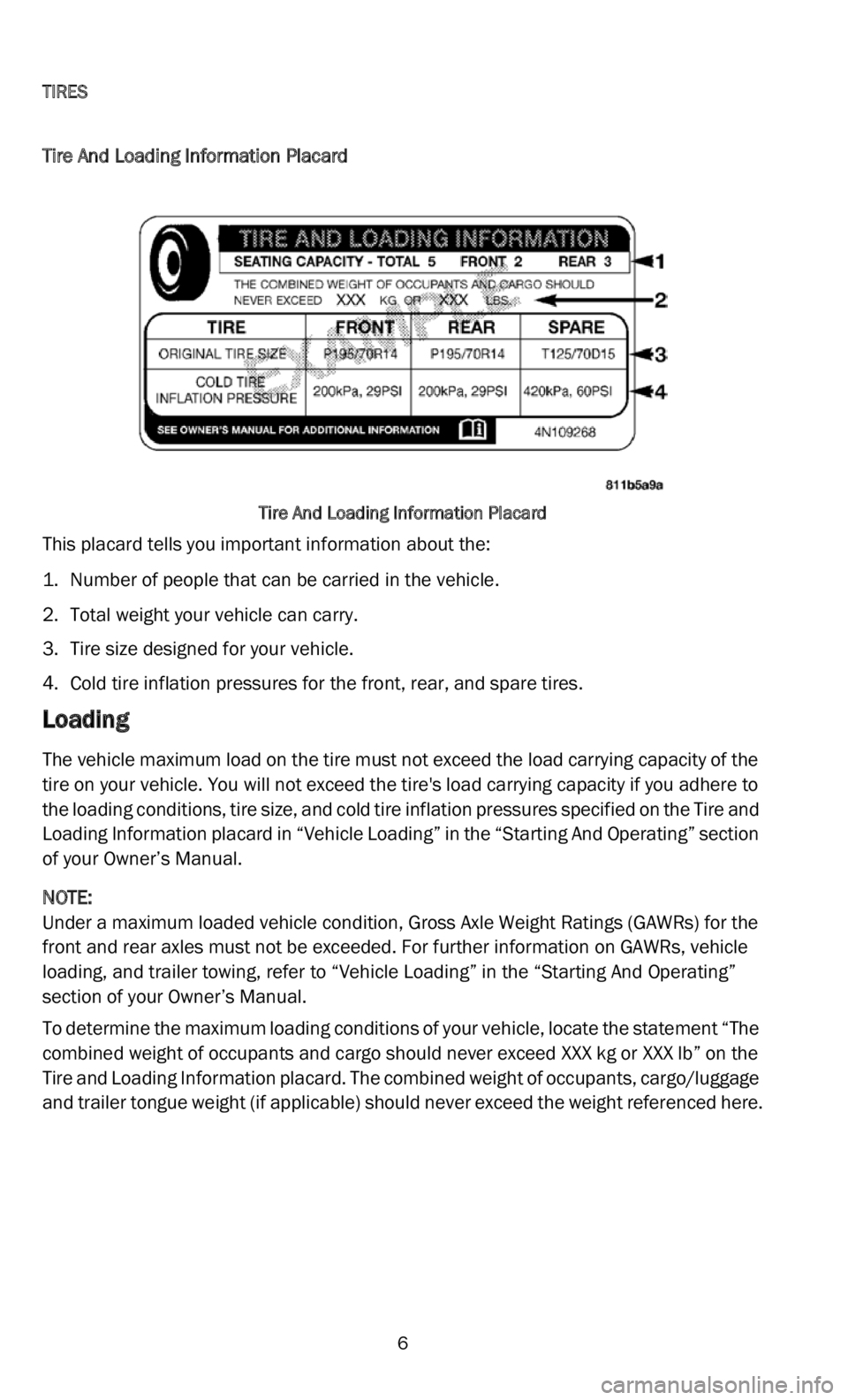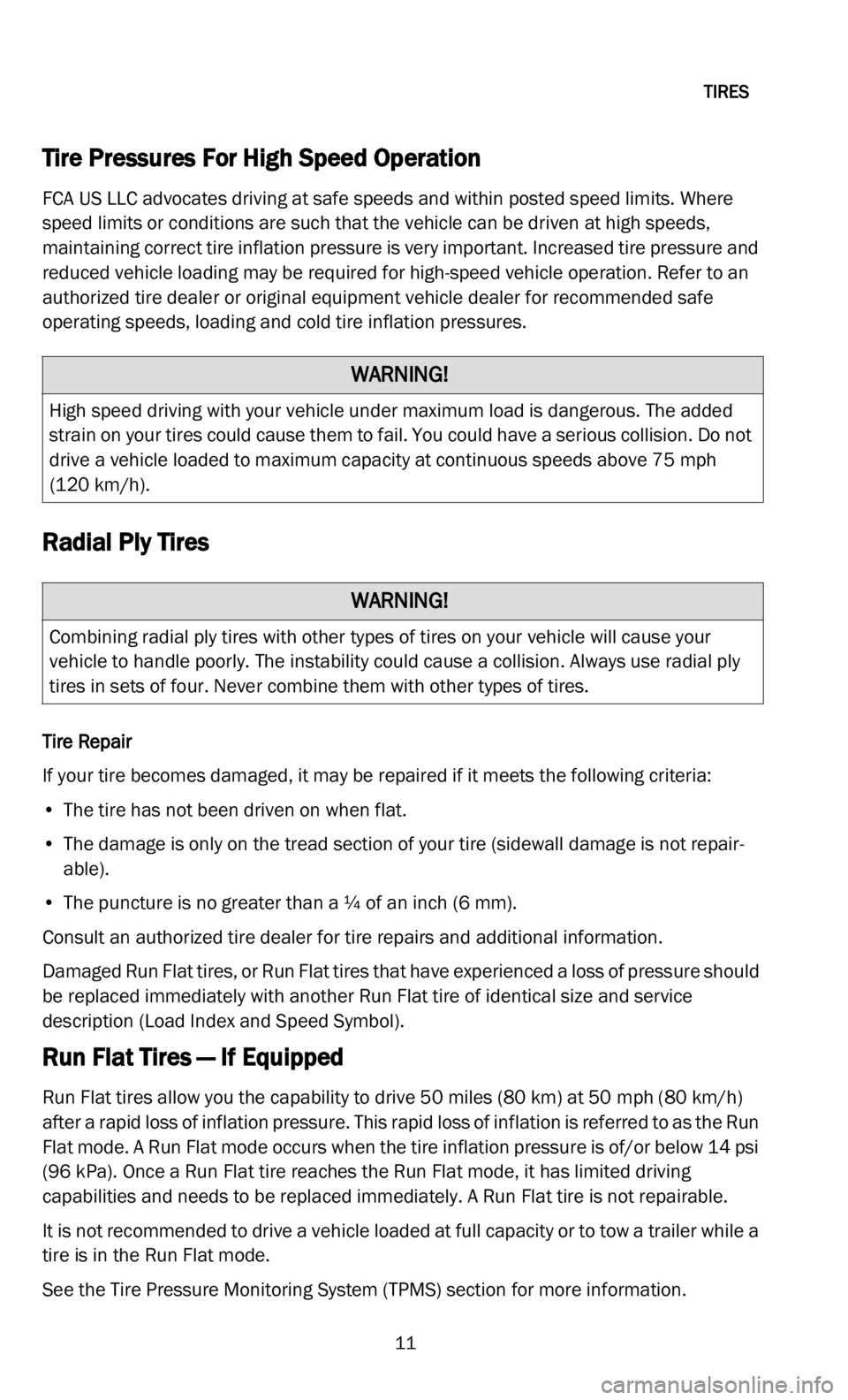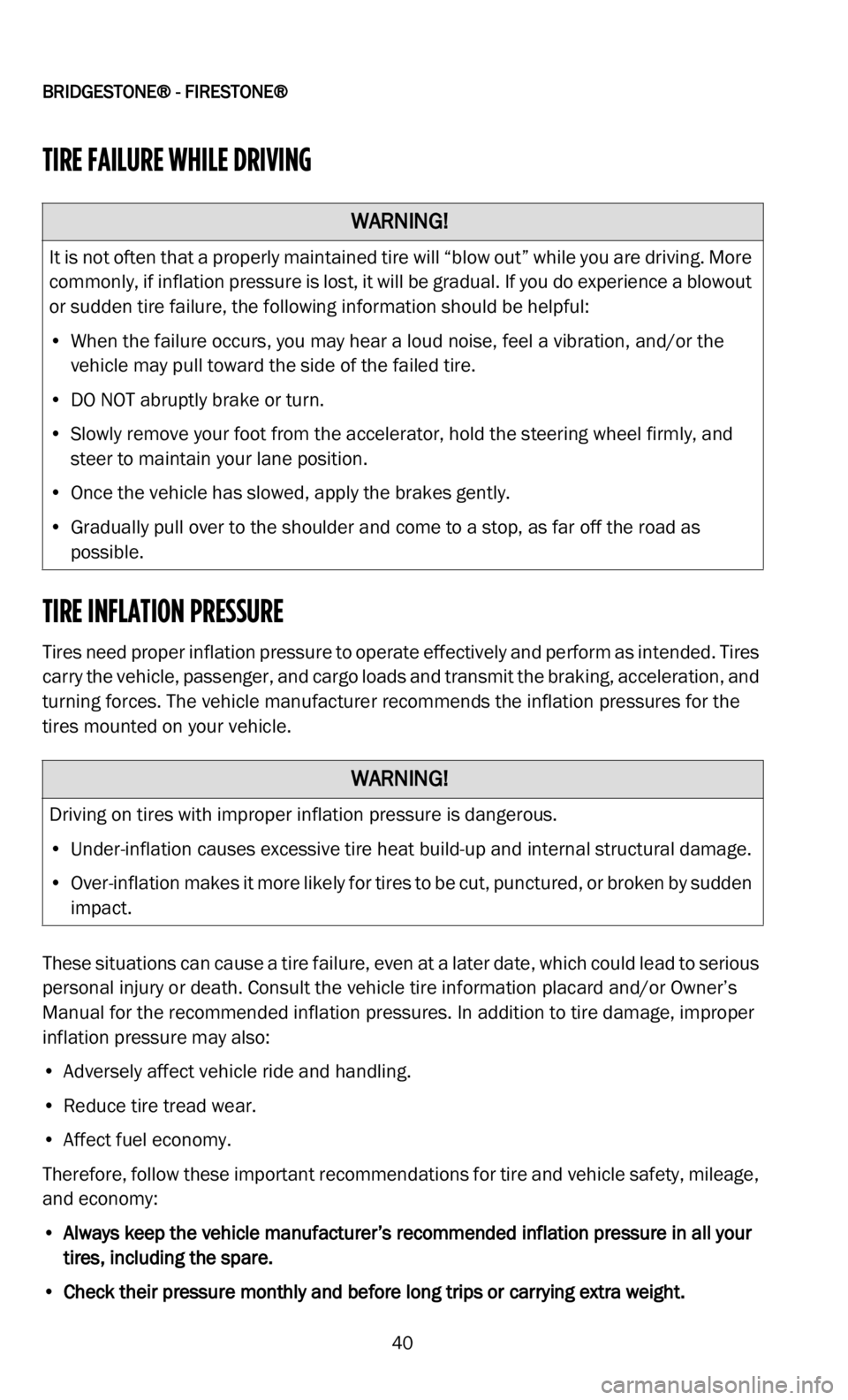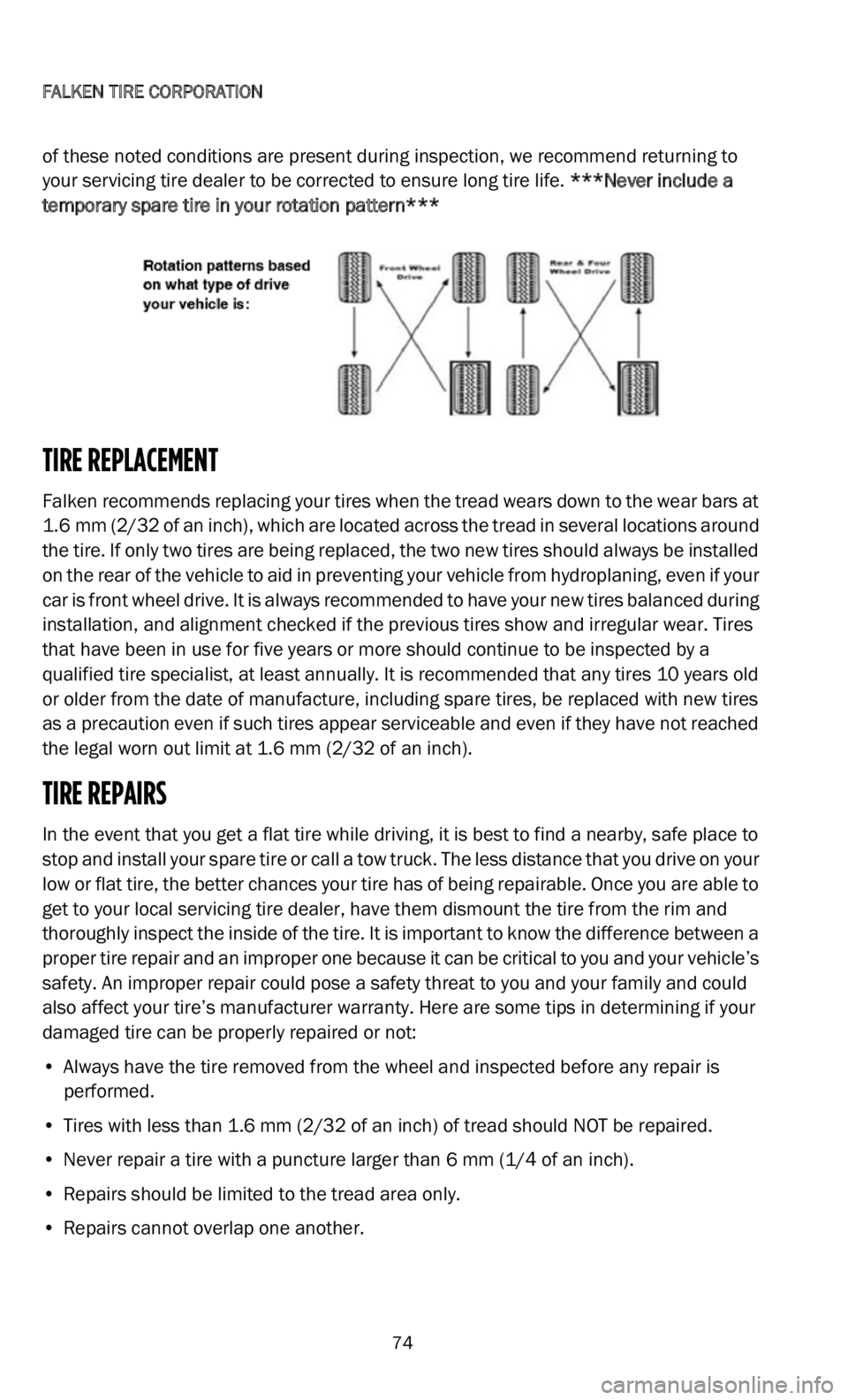tow DODGE DURANGO 2022 Vehicle Warranty
[x] Cancel search | Manufacturer: DODGE, Model Year: 2022, Model line: DURANGO, Model: DODGE DURANGO 2022Pages: 200, PDF Size: 6.72 MB
Page 7 of 200

TIRES
6
Tire And Loading Information Placard
Tire And Loading Information Placard
This placard tells you important information about the:
1. Number of people that can be carried in the vehicle.
2.
Total weight your vehicle can carry.
3 .
Tire size designed for your vehicle.
4 .
Cold tire inflation pressures for the front, rear, and spare tires.
Loading
The vehicle maximum load on the tire must not exceed the load carrying capacity of the
tire on your vehicle. You will not exceed the tire's load carrying capacity if you adhere to
the loading conditions, tire size, and cold tire inflation pressures specified on the Tire and
Loading Information placard in “Vehicle Loading” in the “Starting And Operating” section
of your Owner’s Manual.
NOTE:
Under a maximum loaded vehicle condition, Gross Axle Weight Ratings (GAWRs) for the
f r o
nt and rear axles must not be exceeded. For further information on GAWRs, vehicle
loading, and trailer towing, refer to “Vehicle Loading” in the “Starting And Operating”
section of your Owner’s Manual.
To determine the maximum loading conditions of your vehicle, locate the statement “The
co m
bined weight of occupants and cargo should never exceed XXX kg or XXX lb” on the
Tire and Loading Information placard. The combined weight of occupants, cargo/luggage
and trailer tongue weight (if applicable) should never exceed the weight referenced here.
Page 8 of 200

TIRES
7
Steps For Determining Correct Load Limit—
(1) Locate the statement “The combined weight of occupants and cargo should never
ex c
eed XXX kg or XXX lb” on your vehicle's placard.
(2) Determine the combined weight of the driver and passengers that will be riding in
yo u
r vehicle.
(3) Subtract the combined weight of the driver and passengers from XXX kg or
XXX lb.
(4) The resulting figure equals the available amount of cargo and luggage load capacity.
Fo r
example, if “XXX” amount equals 1,400 lb and there will be five 150 lb passengers
in your vehicle, the amount of available cargo and luggage load capacity is 650 lb
(1,400-750 (5x150) = 650 lb).
(5) Determine the combined weight of luggage and cargo being loaded on the vehicle.
Th a
t weight may not exceed the available cargo and luggage load capacity calculated in
Step 4.
(6) If your vehicle will be towing a trailer, the load from your trailer will be transferred to
yo u
r vehicle. Consult this manual to determine how this reduces the available cargo and
luggage load capacity of your vehicle.
Metric Example For Load Limit
For example, as shown in step 4 above, if “XXX” amount equals 635 kg and there will be
fi v
e 68 kg passengers in your vehicle, the amount of available cargo and luggage load
capacity is 295 kg (635-340 (5x68) = 295 kg).
NOTE:
• If your vehicle will be towing a trailer, the load from your trailer will be transferred to yo
ur vehicle. The following table shows examples on how to calculate total load,
cargo/luggage, and towing capacities of your vehicle with varying seating configura -
tions and number and size of occupants. This table is for illustration purposes only and
ma y
not be accurate for the seating and load carrying capacity of your vehicle.
• For the following example, the combined weight of occupants and cargo should never ex
ceed 865 lb (392 kg).
Page 12 of 200

TIRES
11
Tire Pressures For High Speed Operation
FCA US LLC advocates driving at safe speeds and within posted speed limits. Where
speed limits or conditions are such that the vehicle can be driven at high speeds,
maintaining correct tire inflation pressure is very important. Increased tire pressure and
reduced vehicle loading may be required for high-speed vehicle operation. Refer to an
authorized tire dealer or original equipment vehicle dealer for recommended safe
operating speeds, loading and cold tire inflation pressures.
Radial Ply Tires
Tire Repair
If your tire becomes damaged, it may be repaired if it meets the following criteria:
• The tire has not been driven on when flat.
• Th
e damage is only on the tread section of your tire (sidewall damage is not repair -
a b
le).
• The puncture is no greater than a ¼ of an inch (6 m
m).
Consult an authorized tire dealer for tire repairs and additional information.
Damaged Run Flat tires, or Run Flat tires that have experienced a loss of pressure should
be
replaced immediately with another Run Flat tire of identical size and service
description (Load Index and Speed Symbol).
Run Flat Tires — If Equipped
Run Flat tires allow you the capability to drive 50 miles (80 km) at 50 mph (80 km/h)
aft
er a rapid loss of inflation pressure. This rapid loss of inflation is referred to as the Run
Flat mode. A Run Flat mode occurs when the tire inflation pressure is of/or below 14 psi
(96 kPa). Once a Run Flat tire reaches the Run Flat mode, it has limited driving
capabilities and needs to be replaced immediately. A Run Flat tire is not repairable.
It is not recommended to drive a vehicle loaded at full capacity or to tow a trailer while a
tir
e is in the Run Flat mode.
See the Tire Pressure Monitoring System (TPMS) section for more information.
WARNING!
High speed driving with your vehicle under maximum load is dangerous. The added
strain on your tires could cause them to fail. You could have a serious collision. Do not
drive a vehicle loaded to maximum capacity at continuous speeds above 75 mph
(1 2
0 km/h).
WARNING!
Combining radial ply tires with other types of tires on your vehicle will cause your
vehicle to handle poorly. The instability could cause a collision. Always use radial ply
tires in sets of four. Never combine them with other types of tires.
Page 24 of 200

BFGOODRICH® TIRES
23
SAFETY MAINTENANCE INFORMATION
Read your Tire Owner’s Manual, the information on the sidewall of your tires, your vehicle
Owner’s Manual and vehicle tire information placard for essential safety and
maintenance information.
When service is required:
1. C ontact a participating BFGoodrich® tire retailer listed in your yellow pages.
2
. I f additional assistance is needed in locating a BFGoodrich® retailer, please call or
w
rite to the Consumer Care Department listed in this book.
You should have complete confidence in your new BFGoodrich® tires. Still it is important
t o
register your tires in the event that we need to contact you. For online tire registration,
visit https://www.tireregistration.com/ .
TIRE DISABLEMENT SAFETY WARNING
Any tire may fail as a result of an improperly repaired puncture, impact damage, improper
inflation, overloading or other conditions resulting from use or misuse. Tire failures, such
as a rapid air loss or a tread and belt detachment, may increase risk of injury or death
and/or property damage. To reduce the risk of a tire failure, BFGoodrich® recommends
you thoroughly read and follow the recommendations in this BFGoodrich® Limited
Warranty/Owner’s Manual, the vehicle Owner’s Manual, tire placard information, and tire
sidewall information regarding safety warnings, proper tire use and maintenance.
CONTROLLABILITY
CONTROLLING A VEHICLE WHEN A TIRE FAILURE OCCURS
If a tire failure occurs, you may hear a loud noise, feel a vibration, and/or the vehicle may
pu
ll toward the side of the failed tire. If possible, step on the accelerator momentarily to
maintain forward momentum and ensure vehicle control.
It is important that you DO NOT BRAKE OR ABRUPTLY TURN THE STEERING WHEEL.
Slowly remove your foot from the accelerator and hold the steering wheel firmly while
s t
eering to remain in your lane. Once the vehicle has slowed and is fully under control,
apply the brakes gently; safely pull over to the shoulder and come to a stop. Inspect the
tires. If one or more tires look flat or low, show detachment or other damage, remove tire
assembly and replace it with a properly inflated spare. Bumps or bulges may indicate
detachment within the tire body and require inspection by a qualified tire technician.
WARNING!
DISREGARDING ANY OF THE SAFETY PRECAUTIONS AND/OR INSTRUCTIONS
CONTAINED IN THIS MANUAL MAY RESULT IN TIRE FAILURE OR EXPLOSION CAUSING
SERIOUS PERSONAL INJURY OR DEATH.
Page 29 of 200

BFGOODRICH® TIRES
28
All tires will wear out faster when subjected to high speeds as well as hard cornering,
rapid starts, sudden stops, frequent driving on roads which are in poor condition, and off
road use. Roads with holes and rocks or other objects can damage tires and cause
misalignment of your vehicle. When driving on such roads, drive carefully and slowly, and
before driving again at normal or highway speeds, examine your tires for any damage,
such as cuts, bulges, penetrations, unusual wear patterns, etc.
WEAR BARS
BFGoodrich® tires contain “Wear-Bars” in the grooves of the tire tread which show up
when only 2/32 of an inch (1.6 mm) of tread is remaining. At this stage, your tires must
b e
replaced. Tires worn beyond this stage are extremely dangerous.
DO NOT OVERLOAD - DRIVING ON ANY OVERLOADED TIRE IS DANGEROUS
The maximum load rating of your tires is molded on the tire sidewall. Do not exceed this
ra
ting. Follow the loading instructions of FCA US LLC and this will ensure that your tires
are not overloaded. Tires which are loaded beyond their maximum allowable loads for
the particular application will build up excessive heat that may result in sudden tire
destruction.
Do not exceed the Gross Axle Weight Rating (GAWR) for any axle on your vehicle.
TRAILER TOWING
If you anticipate towing a trailer, you should visit any BFGoodrich® tire retailer for advice
concerning the correct size tire and pressures. Tire size and pressures will depend upon
the type and size of trailer and hitch utilized, but in no case must the maximum cold
inflation pressure or tire load rating be exceeded. Check the tire decal and the Owner’s
Manual supplied by FCA US LLC for further recommendations on trailer towing.
WHEEL ALIGNMENT AND BALANCING ARE IMPORTANT FOR SAFETY AND MAXIMUM
MI
LEAGE FROM YOUR TIRES
CHECK HOW YOUR TIRES ARE WEARING AT LEAST ONCE EACH MONTH
If your tires are wearing unevenly, such as the inside shoulder of the tire wearing faster
th
an the rest of the tread, or if you detect excessive vibration, your vehicle may be out of
alignment or balance. These conditions not only shorten the life of your tires but
adversely affect the handling characteristics of your vehicle, which could be dangerous.
If you detect irregular wear or vibration, have your alignment and balance checked
immediately. Tires which have been run underinflated will show more wear on the
shoulders than in the center of the tread.
TIRE MIXING
BFGoodrich® tires are radial tires and for best performance it is recommended that the
same size and type of tire be used on all four wheel positions. Before mixing tires of
different types in any configuration on any vehicle, be sure to check the vehicle
manufacturer’s Owner‘s Manual for its recommendations.
Page 41 of 200

BRIDGESTONE® - FIRESTONE®
40
TIRE FAILURE WHILE DRIVING
TIRE INFLATION PRESSURE
Tires need proper inflation pressure to operate effectively and perform as intended. Tires
carry the vehicle, passenger, and cargo loads and transmit the braking, acceleration, and
turning forces. The vehicle manufacturer recommends the inflation pressures for the
tires mounted on your vehicle.
These situations can cause a tire failure, even at a later date, which could lead to serious
pe
rsonal injury or death. Consult the vehicle tire information placard and/or Owner’s
Manual for the recommended inflation pressures. In addition to tire damage, improper
inflation pressure may also:
• A dversely affect vehicle ride and handling.
•
Reduce tire tread wear.
•
Affect fuel economy.
T
herefore, follow these important recommendations for tire and vehicle safety, mileage,
a n
d economy:
• Always keep the vehicle manufacturer’s recommended inflation pressure in all your
t
ires, including the spare.
• Check their pressure monthly and before long trips or carrying extra weight.
WARNING!
It is not often that a properly maintained tire will “blow out” while you are driving. More
commonly, if inflation pressure is lost, it will be gradual. If you do experience a blowout
or sudden tire failure, the following information should be helpful:
• W hen the failure occurs, you may hear a loud noise, feel a vibration, and/or the
v
ehicle may pull toward the side of the failed tire.
• D O NOT abruptly brake or turn.
•
Slowly remove your foot from the accelerator, hold the steering wheel firmly, and
s
teer to maintain your lane position.
• O nce the vehicle has slowed, apply the brakes gently.
•
Gradually pull over to the shoulder and come to a stop, as far off the road as
p
ossible.
WARNING!
Driving on tires with improper inflation pressure is dangerous.
• U nder-inflation causes excessive tire heat build-up and internal structural damage.
•
Over-inflation makes it more likely for tires to be cut, punctured, or broken by sudden
i
mpact.
Page 44 of 200

BRIDGESTONE® - FIRESTONE®
43
• Never exceed the Gross Vehicle Weight Rating (GVWR) or front/rear Gross Axle Weight Rating (GAWR) of your vehicle.
• C onsult your vehicle Owner’s Manual for load recommendations and special instruc -
t
ions such as for trailer/towing and snow plow installations.
TIRE DAMAGE, INSPECTION AND SERVICE LIFE
Evaluation and maintenance of your tires is important to their performance and the
service they provide to you. Over time and/or through use, the condition of a tire can
change from exposure to everyday road conditions, the environment, damaging events
such as punctures, and other external factors.
You should visually inspect your tires on a regular basis throughout their life, and you
sh
ould have your tires periodically evaluated by a qualified tire service professional when
your vehicle is serviced such as routine maintenance intervals, oil changes, and tire
rotations. In particular, note the following tips for spotting tire damage:
• A fter striking anything unusual in the roadway, have a qualified tire service profes -
s
ional demount the tire and inspect it for damage. A tire may not have visible signs of
d a
mage on the tire surface. Yet, the tire may suddenly fail without warning, a day, a
week, or even months later.
• I nspect your tires for cuts, cracks, splits or bruises in the tread and sidewall areas.
B
umps or bulges may indicate a separation within the tire body. Have your tire
inspected by a qualified tire service professional. It may be necessary to have it
removed from the wheel for a complete inspection.
• I nspect your tires for adequate tread depth. When the tire is worn to the built-in indi -
c
ators at 2/32 of an inch (1.6 mm) or less tread groove depth, or the tire cord or fabric
i s
exposed, the tire is dangerously worn and must be replaced immediately.
• I nspect your tires for uneven wear. Wear on one side of the tread or flat spots in the
t
read may indicate a problem with the tire or vehicle. Consult a qualified tire service
professional.
• I nspect your wheels also. If you have a bent or cracked wheel, it must be replaced.
•
Don’t forget to check the spare tire.
M
ake sure your tires, including the spare tire, continue to be regularly inspected after 5
y e
ars of service to determine if they can continue in service. Even when your tires appear
to be usable from their external appearance or the tread depth may have not reached
the minimum wear out depth, it is recommended that all tires (including spare tires and
“temporary use” spares) more than 10 years old be replaced with new tires.
WARNING!
Driving on damaged tires is dangerous. A damaged tire can suddenly fail causing
serious personal injury or death. Have your tires regularly inspected by a qualified tire
service professional.
Page 56 of 200

BRIDGESTONE® - FIRESTONE®
55
The vehicle or TPMS manufacturer may advise checking the TPMS regularly to confirm it
is in working order. In addition, a new pressure sensor, certain components, or
reprogramming may be necessary when a tire is serviced. Consult your vehicle Owner’s
Manual, vehicle manufacturer, or a Bridgestone® Firestone® Run-Flat Certified Retailer
for questions regarding TPMS operation and service.
RUN-FLAT OR LOW TIRE PRESSURE OPERATION
General Instructions
The Tire Pressure Monitoring System (TPMS) required in your vehicle may have different
m e
thods of alerting you when your tire has lost inflation pressure. The international
standard for the definition of run-flat operation is pressure at or below 10 psi (70 kPa);
however, some vehicle manufacturers may have established a different pressure limit.
Consult your vehicle Owner’s Manual for the details of your TPMS. Once the TPMS has
indicated that a tire has reduced inflation pressure, the run-flat mode of operation has
commenced. During this phase of operation, please follow these instructions:
• Reduce speed as much as safely and reasonably possible; do not exceed 50 m
ph
(8
0 km/h). The greater the speed, the less distance the tire can travel.
• Avoid abrupt or aggressive acceleration, braking, or cornering maneuvers as much as
s
afely and reasonably possible. Pot holes and other road hazards should be avoided.
Careful driving limits potential damage to the tire, wheel, and vehicle.
• Proceed to a safe and convenient location for tire service as soon as possible.
Take
note of your mileage; your operation distance is limited. See "Distance—How Far You
Can Drive,” the next section in this manual.
• If an unusual vibration or vehicle handling difficulty arises, stop driving as soon as
s
afely and reasonably possible. The tire may be about to suddenly fail. Release the
accelerator and gradually reduce speed. The tire will need to be replaced before
proceeding.
• If towing a trailer, stop driving as soon as safely and reasonably possible. In this condi -
t
ion, it is potentially dangerous to operate a vehicle/trailer combination. I
f possible,
disconnect the trailer and proceed as noted above. Do not continue to tow any trailer
until proper tire service or replacement has been performed.
• Do not touch a tire recently run-low or run-flat (it may be very hot).
Allow the tire to cool
before handling.
WARNING!
Serious personal injury or death may result from a tire failure or accident due to
improper run-flat or low tire pressure operation. Read and follow the instructions
below, and the other maintenance and safety recommendations elsewhere in this
manual.
Page 70 of 200

CONTINENTAL TIRE
69
regardless of mileage or months of service. This includes payment for tire rotation,
alignment, towing, road service, valve stems and tire repairs.
Owner is responsible for maintaining proper tire air pressure and for proper maintenance
o f
the tire.
SAFETY WARNING:
Ignoring any of the safety and information contained in this warranty may result in tire
f a
ilure, causing serious injury or death.
• Tire failure due to underinflation/overloading.
Follow vehicle Owner’s Manual or tire
placard in vehicle for proper inflation and loading.
• Explosion of tire/rim assembly due to improper tire mounting.
Tire mounting/
demounting can be dangerous. It should be performed only by a trained tire specialist
using proper tools and procedures. Prior to tire mounting/demounting, the US Tire
Manufacturers Association (USTMA) wall charts and manuals should be read to obtain
the proper procedures. The failure to follow these procedures may result in faulty posi -
tioning of the tire and/or rim, which may cause the assembly to burst with force suffi -
cient to cause injury or death.
• T
ire failure due to damage.
Inspect your tires frequently for scrapes, bulges, separa -
tions, cuts, snags and other damage from road hazards. Damage from impact can
o c
cur to the inner portions of your tire without being visible to the outside. If you
suspect a tire has been damaged from striking anything unusual in the road, you must
have the tire removed from the rim and inspected both inside and out by a trained tire
specialist. Air loss or unusual tire wear can also be warning signs that a tire may have
internal damage. If you notice these conditions, have your tire inspected by a trained
individual.
• T ire failure due to excessive tire spinning. A
void tire spinning. The centrifugal force
generated by a free-spinning tire/rim assembly may cause a sudden tire explosion
resulting in vehicle damage and/or serious injury or death. Never exceed 35 mph
( 5
5km/h) as indicated on your speedometer when your vehicle is stuck in snow, mud,
or sand and your tire(s) is/are spinning. Use a gentle backward and forward rocking
motion to free your vehicle for continued driving. Never stand or permit anyone else to
stand near or behind a tire spinning while attempting to push a vehicle that is stuck.
SELF SUPPORTING RUNFLAT (SSR) TIRE OWNERS
Continental Tire the Americas, LLC (CTA) does not recommend any repair to or reuse of
punctured Continental SSR tires.
Even a trained tire specialist may be unable to recognize internal structural damage to a
S e
lf Supporting Run-flat (SSR) tire resulting from having been driven in an under inflated
or zero inflation pressure condition. Such damage may not be visible on the surface of
the inner liner or sidewall making it impossible to determine the tire suitability for repair
or reuse. CTA does not recommend any repair to or reuse of Continental SSR tires. You
may visit https://www.continentaltire.com/ or www.continentaltire.ca and select
Customer Care FAQs to obtain additional SSR information.
Page 75 of 200

FALKEN TIRE CORPORATION 74
of these noted conditions are present during inspection, we recommend returning to
your servicing tire dealer to be corrected to ensure long tire life. ***Never include a
temporary spare tire in your rotation pattern***
TIRE REPLACEMENT
Falken recommends replacing your tires when the tread wears down to the wear bars at
1.6 mm (2/32 of an inch), which are located across the tread in several locations around
t h
e tire. If only two tires are being replaced, the two new tires should always be installed
on the rear of the vehicle to aid in preventing your vehicle from hydroplaning, even if your
car is front wheel drive. It is always recommended to have your new tires balanced during
installation, and alignment checked if the previous tires show and irregular wear. Tires
that have been in use for five years or more should continue to be inspected by a
qualified tire specialist, at least annually. It is recommended that any tires 10 years old
or older from the date of manufacture, including spare tires, be replaced with new tires
as a precaution even if such tires appear serviceable and even if they have not reached
the legal worn out limit at 1.6 mm (2/32 of an inch).
TIRE REPAIRS
In the event that you get a flat tire while driving, it is best to find a nearby, safe place to
stop and install your spare tire or call a tow truck. The less distance that you drive on your
low or flat tire, the better chances your tire has of being repairable. Once you are able to
get to your local servicing tire dealer, have them dismount the tire from the rim and
thoroughly inspect the inside of the tire. It is important to know the difference between a
proper tire repair and an improper one because it can be critical to you and your vehicle’s
safety. An improper repair could pose a safety threat to you and your family and could
also affect your tire’s manufacturer warranty. Here are some tips in determining if your
damaged tire can be properly repaired or not:
• Always have the tire removed from the wheel and inspected before any repair is
p
erformed.
• T ires with less than 1.6
mm (2/32 of an inch) of tread should NOT be repaired.
• N ever repair a tire with a puncture larger than 6
mm (1/4 of an inch).
• R epairs should be limited to the tread area only.
•
Repairs cannot overlap one another.